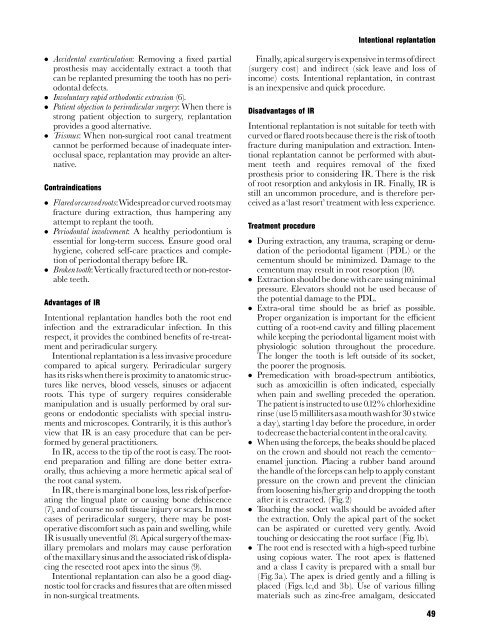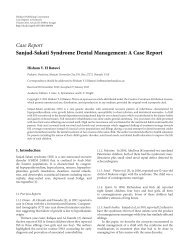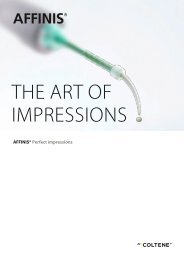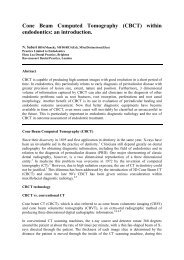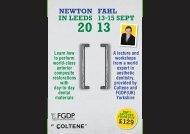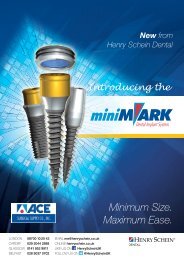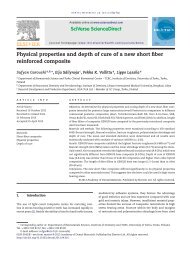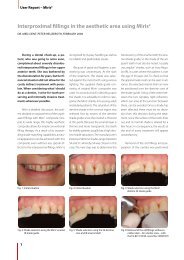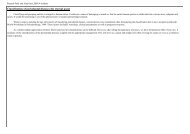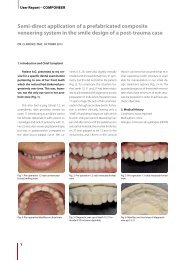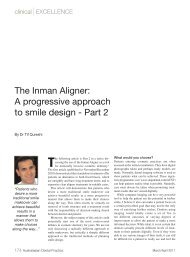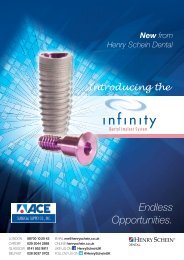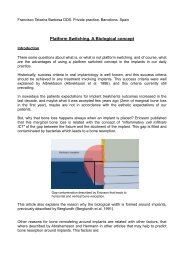Intentional replantation ^ a `last resort' treatment or a ...
Intentional replantation ^ a `last resort' treatment or a ...
Intentional replantation ^ a `last resort' treatment or a ...
Create successful ePaper yourself
Turn your PDF publications into a flip-book with our unique Google optimized e-Paper software.
<strong>Intentional</strong> <strong>replantation</strong><br />
Accidental exarticulation: Removing a ¢xed partial<br />
prosthesis may accidentally extract a tooth that<br />
can be replanted presuming the tooth has no periodontal<br />
defects.<br />
Involuntary rapid <strong>or</strong>thodontic extrusion (6).<br />
Patient objection to periradicular surgery:Whenthereis<br />
strong patient objection to surgery, <strong>replantation</strong><br />
provides a good alternative.<br />
Trismus: When non-surgical root canal <strong>treatment</strong><br />
cannot be perf<strong>or</strong>med because of inadequate interocclusal<br />
space, <strong>replantation</strong> may provide an alternative.<br />
Contraindications<br />
Flared<strong>or</strong>curvedroots:Widespread<strong>or</strong>curvedrootsmay<br />
fracture during extraction, thus hampering any<br />
attempt to replant the tooth.<br />
Periodontal involvement: A healthy periodontium is<br />
essential f<strong>or</strong> long-term success. Ensure good <strong>or</strong>al<br />
hygiene, cohered self-care practices and completion<br />
of periodontal therapy bef<strong>or</strong>e IR.<br />
Brokentooth:Vertically fracturedteeth <strong>or</strong> non-rest<strong>or</strong>able<br />
teeth.<br />
Advantages of IR<br />
<strong>Intentional</strong> <strong>replantation</strong> handles both the root end<br />
infection and the extraradicular infection. In this<br />
respect, it provides the combined bene¢ts of re-<strong>treatment</strong><br />
and periradicular surgery.<br />
<strong>Intentional</strong> <strong>replantation</strong> is a less invasive procedure<br />
compared to apical surgery. Periradicular surgery<br />
has its riskswhenthere is proximity toanatomic structures<br />
like nerves, blood vessels, sinuses <strong>or</strong> adjacent<br />
roots. This type of surgery requires considerable<br />
manipulation and is usually perf<strong>or</strong>med by <strong>or</strong>al surgeons<br />
<strong>or</strong> endodontic specialists with special instruments<br />
and microscopes. Contrarily, it is this auth<strong>or</strong>'s<br />
view that IR is an easy procedure that can be perf<strong>or</strong>med<br />
by general practitioners.<br />
In IR, access to the tip of the root is easy.The rootend<br />
preparation and ¢lling are done better extra<strong>or</strong>ally,<br />
thus achieving a m<strong>or</strong>e hermetic apical seal of<br />
the root canal system.<br />
In IR, there is marginalbone loss, less riskofperf<strong>or</strong>ating<br />
the lingual plate <strong>or</strong> causing bone dehiscence<br />
(7), and of course no soft tissue injury <strong>or</strong> scars. In most<br />
cases of periradicular surgery, there may be postoperative<br />
discomf<strong>or</strong>t such as pain and swelling, while<br />
IRisusuallyuneventful(8).Apicalsurgeryofthemaxillary<br />
premolars and molars may cause perf<strong>or</strong>ation<br />
of the maxillarysinusandthe associatedriskof displacing<br />
the resected root apex into the sinus (9).<br />
<strong>Intentional</strong> <strong>replantation</strong> can also be a good diagnostic<br />
tool f<strong>or</strong> cracks and ¢ssures that are oftenmissed<br />
in non-surgical <strong>treatment</strong>s.<br />
Finally, apical surgery isexpensiveinterms ofdirect<br />
(surgery cost) and indirect (sick leave and loss of<br />
income) costs. <strong>Intentional</strong> <strong>replantation</strong>, in contrast<br />
is an inexpensive and quick procedure.<br />
Disadvantages of IR<br />
<strong>Intentional</strong> <strong>replantation</strong> is not suitable f<strong>or</strong> teeth with<br />
curved <strong>or</strong> £ared rootsbecause there is the riskoftooth<br />
fracture during manipulation and extraction. <strong>Intentional</strong><br />
<strong>replantation</strong> cannot be perf<strong>or</strong>med with abutment<br />
teeth and requires removal of the ¢xed<br />
prosthesis pri<strong>or</strong> to considering IR. There is the risk<br />
of root res<strong>or</strong>ption and ankylosis in IR. Finally, IR is<br />
still an uncommon procedure, and is theref<strong>or</strong>e perceived<br />
as a<strong>`last</strong> <strong>res<strong>or</strong>t'</strong><strong>treatment</strong> with less experience.<br />
Treatment procedure<br />
During extraction, any trauma, scraping <strong>or</strong> denudation<br />
of the periodontal ligament (PDL) <strong>or</strong> the<br />
cementum should be minimized. Damage to the<br />
cementum may result in root res<strong>or</strong>ption (10).<br />
Extraction shouldbe donewithcare using minimal<br />
pressure. Elevat<strong>or</strong>s should not be used because of<br />
the potential damage to the PDL.<br />
Extra-<strong>or</strong>al time should be as brief as possible.<br />
Proper <strong>or</strong>ganization is imp<strong>or</strong>tant f<strong>or</strong> the e¤cient<br />
cutting of a root-end cavity and ¢lling placement<br />
while keeping the periodontal ligament moist with<br />
physiologic solution throughout the procedure.<br />
The longer the tooth is left outside of its socket,<br />
the po<strong>or</strong>er the prognosis.<br />
Premedication with broad-spectrum antibiotics,<br />
such as amoxicillin is often indicated, especially<br />
when pain and swelling preceded the operation.<br />
The patient is instructedto use 0.12% chl<strong>or</strong>hexidine<br />
rinse(use15 millilitersasamouthwashf<strong>or</strong>30 stwice<br />
a day), starting1day bef<strong>or</strong>e the procedure, in <strong>or</strong>der<br />
to decreasethebacterialcontent inthe <strong>or</strong>alcavity.<br />
Whenusing the f<strong>or</strong>ceps, thebeaks shouldbe placed<br />
on the crown and should not reach the cemento^<br />
enamel junction. Placing a rubber band around<br />
the handle of the f<strong>or</strong>ceps can help to apply constant<br />
pressure on the crown and prevent the clinician<br />
from loosening his/her grip and dropping the tooth<br />
after it is extracted. (Fig.2)<br />
Touching the socket walls should be avoided after<br />
the extraction. Only the apical part of the socket<br />
can be aspirated <strong>or</strong> curetted very gently. Avoid<br />
touching <strong>or</strong> desiccating the root surface (Fig.1b).<br />
The root end is resected with a high-speed turbine<br />
using copious water. The root apex is £attened<br />
and a class Icavity is prepared with a small bur<br />
(Fig.3a). The apex is dried gently and a ¢lling is<br />
placed (Figs.1c,d and 3b). Use of various ¢lling<br />
materials such as zinc-free amalgam, desiccated<br />
49


